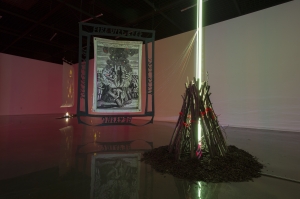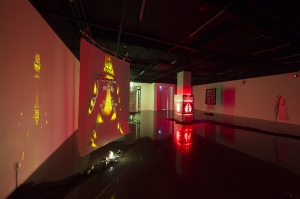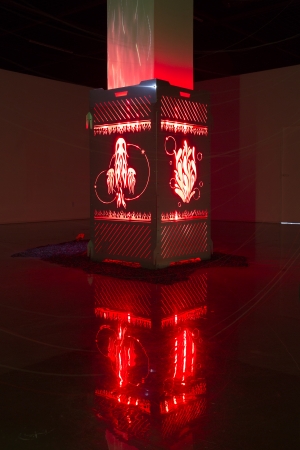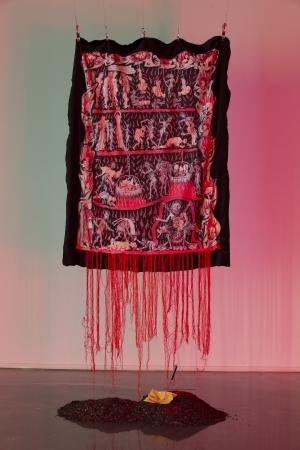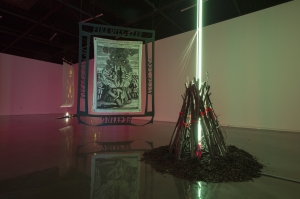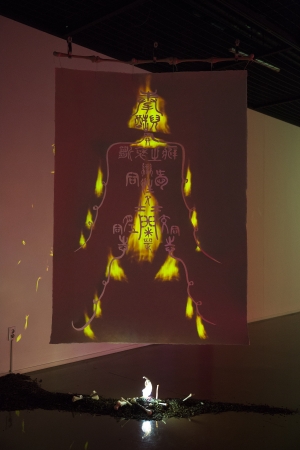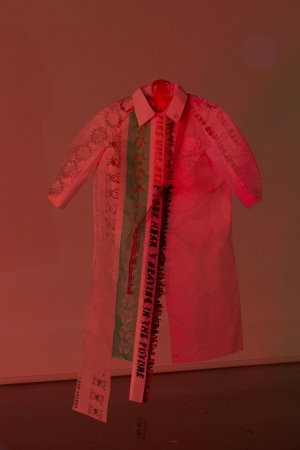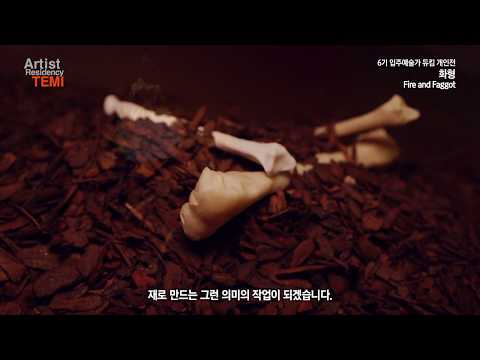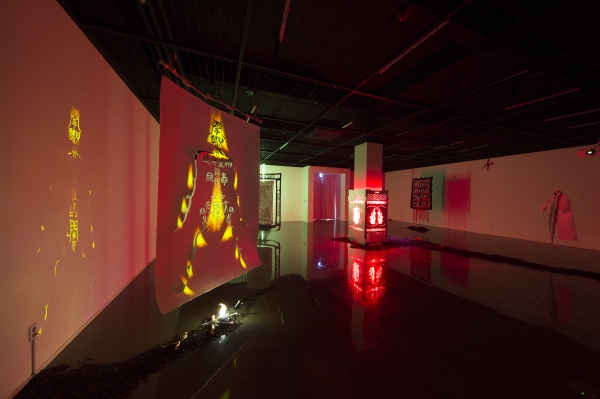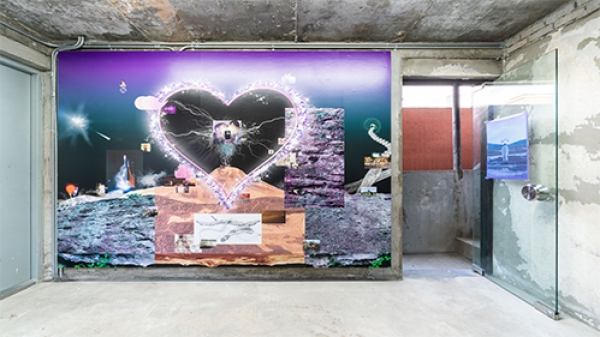전시 EXHIBITION
입주예술가 개인전화형 Fire and Faggot
불은 창조의 힘이다. 불은 인류 생활에 주요한 수단이 되어갔다. 사람들은 호모사피엔스가 불의 사용을 전제로 진화했다고 이야기 한다. 불은 변화 혹은 변형의 힘으로 간주되었다. 충남, 대전의 굿인 설위설경의 의식에서도 볼 수 있듯이 한국의 무당들은 사로잡힌 영혼을 풀어주기 위해 부작을 태운다. 불로 태우는 의식을 통해 어떠한 물질이 다른 영적인 차원으로 운반된다고 믿는다. 불은 선언이고 혁명이다. 우리는 신(절대자)에게서 뺏어온 불에 대한 이야기를 여러 신화에서 찾을 수 있다. 그리고 우리는 변화의 시점에서 손에 불을 쥔다.
불은 파과의 힘이다. 불은 인류에게 재앙을 주기도 했다. 성경에서 소돔과 고모라는 불과 우황의 비로 멸망하였고, 불교와 기독교에서 지옥을 불구덩이로 묘사하듯이 형별의 의미로도 사용되었다. 중세 유럽에서는 주류신앙에 반대했던 사람들, 강한 의지를 가진 여성, 혹은 동성애자들이 화형을 당했다.
이번 전시에서 작가 듀킴은 자신이 만든 샤먼(HornyHoneydew)으로 인류를 포스트휴먼으로 전환하기 위해 불을 사용한다. 불의 의식을 통해 인류는 연기가 되어 지구를 탈출하고 새로운 땅에서 새로운 시작을 맞이할 것이다.
+++++++++++++++++++++++++++++++++++++++++++
모국의 부재 혹은 새로운 종족의 탄생
정현 인하대학교 교수
“나는 너무나 빨리 자신의 부모를 무시해 버린 한 아이를 상상한다. 아이는 겁에 질려 ‘완전히 혼자’가 되고, 그런 상태로부터 도망치기 위해 자기에게 주어진 모든 소여나 대상들을 내던져 버리고 토해 버린다.”
- 줄리아 크리스테바, 공포의 권력 27쪽
오늘날 동성애 작가가 자신의 정체성을 기반으로 한 작업을 두고 비평적 글쓰기를 수행하는 것은 생각만큼 쉽지 않은 과제이다. 동성애란 단어나 젠더의 개념이 어느 정도 일반화되어가는 현실에서 1970~80년대와 같은 논란이나 반향을 오늘날 일으키기는 어려운 것도 하나의 원인일 것이다. 굳이 비평의 어려움을 사회적 영역에서 찾는다면, 어떤 주제나 분야에서도 유독 속도전에 능숙한 한국사회의 특징 덕분인지 모르겠지만, 한국의 동성애는 충분히 다뤄진 적이 없었음에도 불구하고 현재 시점에서 동성애 작가의 작업에 대한 비평적 글쓰기를 한다는 게 이렇게 빈곤하게 느껴질지는 나 자신도 미처 예상하지 못했다. 가능한 원인을 찾아보니, 듀킴의 작업은 유독 나에게 정동을 일으키지 않았다. 감정의 동요도 공감의 지점도 쉽게 발견되지 않았다. 예컨대 펠릭스 곤잘레즈-토레스의 작업을 두고 니콜라 부리요는 시각이 아닌 공감을 통한 새로운 미학적 체제를 이끌어낸 작가로 정의내린 바 있다. 곤잘레즈-토레스의 작업은 성정체성의 차이를 넘어 보편적인 사랑의 감정과 조응한다. 이처럼 동성애의 자기 서사는 이른바 당사자성이란 ‘말하는 주체’가 자신의 언어를 구축하는 과정으로 인식된다. 듀킴 역시 이 과정을 수행하였댜. 그의 석사 논문은 거부할 수 없는 아버지라는 신적 대상과 기독교 교리의 억압과 유일한 구원자인 어머니와의 관계로 비롯된 자기 정체성을 찾아가는 자전적 연구논문이다. Dionysia, The true story of my relationship of my body, Doujin Kim, Master Thesis, Royal College of Art, 2015
논문은 자신이 겪은 형언하기 어려운 몸의 충동과 쾌감과 신앙 사이에서 겪는 갈등을 중세 성화와 성경의 일화들을 분석하면서 사적 경험과 신화적 서사를 교차시키면서 성과 속 사이의 어떤 공통분모를 발견한다. 그는 결론에서 부활한 예수야말로 마성스러운 마조히스트라고 해석한다. 위의 책, 91쪽
기독교의 부활 서사는 고통, 희생, 죽음, 부활, 영생은 곤잘레즈-토레스의 작업에서도 발견되는 부분이다. 자신이 머물렀던 침대를 통해 스스로의 부재를 포착한 사진, 포스터로 제작되어 여러 도시 곳곳의 빌보드에서 불쑥 튀어나온 작가의 두툼한 손은 부활 서사를 전유하는 장면이다. 2015년 이후 듀킴은 논문을 통해 밝힌 자신의 마조히즘 성향을 작업의 주요한 동력으로 삼는다. 인공성, 시뮬라크르, 정동의 부재, 유희성 등 하위문화적 코드는 마조히즘의 연극성과 맞닿아 있는 듯하다. 따라서 그의 작업은 자신의 성정체성에 관한 일반적인 고민보다는 어떻게 자신의 성적 쾌락을 통하여 존재양식을 수행할 수 있는지를 탐구하는 것에 더 가까웠다. 무엇보다 가부장적인 아버지와 기독교적 생활양식 탓에 나 이전에 나를 지배하는 아버지라는 상징으로 적지 않은 심리적 고통을 겪고 있는 작가의 상황을 이해하는 게 그의 작업을 해석하는 첫 번째 단서이다.
마조히즘
개인이 동성애자인 ‘나’를 발견하고 인정하는 과정이란 ‘성’을 중심에 놓고 자신을 해체하고 재구축하는 자기부정과 주체형성이 직조되는 역설의 시간이다. 작가는 이 과정을 두고 일반화된 퀴어 담론에서 볼 수 있는 사회적 타자로 고통을 크게 겪지는 않았다고 말한다. 그 대신 가족공동체를 지배하는 신앙에 의한 고통은 현재 진행형이다. 요컨대 이성애 사회에서 본인의 특이성은 유사여성으로 받아들여졌다는 것이다. 이 같은 경험을 거칠게 해석해보자면 듀킴은 사회적 관계에서 젠더 트러블을 겪었다기보다는 오히려 여성처럼 받아들여지면서 갈등을 덜 겪었던 것처럼 들린다. 일련의 회고는 자연/인공의 대립 상황이 논쟁보다는 자연스레 자신의 정체성으로 구축되었다는 것으로 들렸다. 작가는 어린 시절 어머니가 듀킴을 여장시켜 사진을 찍은 기억을 떠올렸다. 아직까지도 어머니가 애호하는 사진이라고 한다. 같은 책, 23쪽
듀킴이 성적 역할을 고정하지 않고 자유롭게 오갈 수 있었던 것은 젠더로서의 이른 경험 덕분이라기보다는 오히려 성적 쾌락이 주는 충만함에 더 가까워 보인다. 그에게 생물학적 신체와 성별의 차이는 크게 중요하지 않다. 그가 성애에 있어서 중요한 건 바로 파트터와 함께 설정한 연극적 상황 안에서 희열을 만끽하는 마조히즘을 추구하기 때문이다. 마조히즘은 성과 사랑의 관계항을 벗어나 성행위를 하나의 연극적 상황으로 삼아 각자가 자신이 맡은 역할을 수행하는 데 초점이 맞춰져 있다. 마조히즘 실천에서 연극성은 단순히 고통을 인내한 후의 쾌감만을 의미하지는 않는다. 중요한 건 그 과정일 텐데, 마조히즘 실천은 관계를 맺는 수행자들이 각각의 역할을 맡는 것으로부터 출발한다. 지배자와 피지배자라는 역할은 일종의 권력구조를 생성하여 마치 자신이 절대자나 희생양이 되는 연극적 경험을 이끌어낸다. 이 연극구조가 마치 지배자와 피지배자의 전형적인 위계질서를 묘사하는 것처럼 보이지만, 실상은 피지배자가 지배자를 생산하는 주체라는 게 마조히즘의 전복성이라고 문화연구가 닉 맨스필드는 주장한다. 따라서 전시 <화형>이란 표제는 단순히 기독교 교리에 의하여 형벌을 받는 희생자라는 해석 이외에 형벌을 통하여 느끼는 반역적인 성적 충동과 쾌락을 전유할 뿐만 아니라 고통의 인내 이후 도래할 상상의 미래까지를 내포한다. <화형>의 서사는 다음과 같이 전개된다: 기독교적 관점에서의 동성애 박해, 이를 저지하는 한국 민속신앙의 주술성의 개입, 중세 미술의 도상과 출처를 파악하기 어려운 부적이란 서로 다른 두 장르의 기호의 겨루기, 불의 의식으로 다시 태어난 똥꼬충 똥꼬충은 남성 동성애자를 비하하는 용어로 영어로는 faggot이다. 여기서 똥꼬충은 당연히 자기비하적인 단어로 사용되었다. 듀킴은 본 전시에서 이처럼 비천한 존재가 순수한 존재로 승화하는 단계를 제시한다.
은 확장된 퀴어 개념을 장착한 새로운 인종 내지는 부족의 식민지를 향한 대항해가 이어진다.
정동의 부재
이처럼 <화형>은 기독교 신화의 구조를 상당부분 거칠게 전유한다. 동성애를 행한 사람들을 화형에 처하는 중세의 이미지를 차용하여 승화된 희생자를 연상시키는 장면은 무엇보다 붉은 기운으로 가득하다(환영, 2019). 듀킴은 이 장면을 순교의 프레임으로 해석한다. 제물이 된 희생자들은 항문신을 섬기는 퀴어들 여기에서의 퀴어는 LGBTQ로 통칭되는 약어를 넘어서 “퀴어가 어느 성적인 종족집단의 정치적 이해관계를 대표하거나 사회의 관용을 청하며 스스로를 소수화하는 논리를 거부하며, 단지 ‘이성애적인 것’만이 아니라 차라리 모든 ‘정상적인 것’의 체제에 관한 철저한 저항을 지향한다고 쓴다.” 퀴어 이론, 슬픈 모국어 중에서 발췌, 문화와 사회(13), 2012. 11, 57~58쪽. 본 논문은 한국에서의 동성애 연구가 과연 앎과 삶의 의지 중에서 어디에 무게를 실고 있었는지를 되묻고 있다.
로 순교는 새로운 신앙의 탄생과 맞물린다. 다들 눈치를 챘다시피 이 종교는 듀킴이 허구로 만든 종교 허니허니듀(HoneyHoneyDew)로 골반과 항문을 형상으로 상징된다. 아버지를 거부하고 항문이라는 비인칭의 장기를 섬긴다는 설정은 매우 전복적인 아브젝시옹이다.
“아브젝시옹은 모든 종교의 구성물과 함께 한다. 그리고 그 구성물들이 와해되었을 때 새로운 방식으로 만들어져 다시 나타난다. 우리는 아브젝시옹의 여러 구성물들이 성스러운 것을 규정하는 것을 발견할 수 있을 것이다.” 줄리아 크리스테바, 공포의 권력, 동문선, 2001, 42쪽
아브젝시옹은 자신의 육체에서 미끄러져 육체의 상실에 이른다. 즉 성스러움이란 정화에 의한 카타르시스를 경험하게 되는데, 바로 이 지점이 마조히즘 실천과 마주치는 부분이다.
“이른바 거세를 승인하는 과정에서 무엇보다 소중한 비대상으로서의 자신의 육체를 제공하는 자를 위해 자기 자신의 육체, 자신의 자아라는 순수한 상태로부터 전락하고 아브젝트해짐으로써 도착성이라는 샛길로부터 벗어난다. 분석 치료의 말기에 우리는 마조히즘의 고통과 환희로부터 그것을 볼 수 있다” 위의 책, 2001, 27쪽
듀킴의 작업에서 정동을 느낄 수 없었던 이유가 여기에 있다. 그의 작업은 기호와 표면만으로 존재한다. 마조히즘 미학은 숭고와 만나는데 이성/감성으로 측정 불가능한 상태이기 때문이다. 동시대 미술에서 자주 발견할 수 있는 지루할 정도의 기계적인 반복과 재조합, 심리상태나 감정이 최대한 억제한 제작 과정 등으로 산출된 이미저리는 디지털 시각문화에 혼합되어 또 다른 숭고의 미학이 나타나는 즈음이기도 하다. 여기에서 듀킴의 작업을 페티시즘의 관점으로 해석할 수도 있을 것 같다. 할 포스터는 마르크스주의의 관점으로 초현실주의와 기계를 해석한 적이 있는데, 자본주의 체제는 생산물과 생산자가 서로 닮아가게 만든다고 주장했다. 이러한 페티시즘은 마조히즘의 존재양식이기도 하다. 그렇게 듀킴은 남/여성도 인간/사물/자연도 아닌 모든 이항대립의 경계에 위치한 퀴어의 세계를 상상한다. 듀킴은 이 유토피아를 Latrinxia로 부르고 행성의 이름은 목욕, 정화를 뜻하는 라틴어 lavatrina에서 유래한다. 이곳에서 똥꼬충은 성별을 넘은 무성 생물로 설정, 순수 상태이자 이상적 상태로 존재하며, 빛을 자양분으로 변이 번식한다. 똥꼬충은 성별과 성적 분열을 초월한 새로운 인간 유형이다.(듀킴의 글 Latrinxia: A New Utopia에서 발췌.
듀킴의 상상하는 미래는 사회라는 구조가 부재하는 한편으로는 종교의 시뮬라크르만으로 이뤄진 세계이다. 모든 구조와 장기를 배제하고 표피만을 끌어온 세계가 무엇인지 잘 상상되지 않는다. 과연 비평적 기반이 부재한 파생실재(hyperreal)로만 이뤄진 세계를 통하여 작가는 무엇을 말할 수 있을까? 크리스테바는 문학의 시원을 향해 하강하는 글쓰기의 실천이 곧 말하는 주체의 의미를 되돌아보는 행위로 해석한다. 어쩌면 듀킴에게도 시원으로의 회귀 그리고 이상 세계의 설정은 단순히 도피 유토피아라는 결론이 아닐 것이다. 완성된 세계가 아닌 그 세계가 어떻게 형성될 수 있는지를 지속적으로 탐구하는 실천들, 크리스테바에게는 그것이 바로 글쓰기인데, 그래야만 여전히 차이를 생산하는 이분법적 문화의 관성을 벗어날 수 있을 테니 말이다.
Absence of Homeland or Birth of a New Breed
Chung Hyun
Professor, Inha Universiity
“I imagine a child who has swallowed up his parents too soon, who frightens himself on that account, 'all by himself,' and, to save himself, rejects and throws up everything that is given to him ? all gifts, all objects.”
- Julia Kristeva, p.27, Powers of Horror
Today, it is not as easy as one may imagine to engage in critical writing on works created by a homosexual artist based on his/her identity. One reason may be that homosexuality, which has become a general term in society, no longer raises as much controversy or repercussions as in the 1970s or 1980s. If we try to find the difficulty of critiques in the social realm, we may point to the characteristics of the Korean society in which we see fast-paced changes occur in contemporary topics or fields all the time. I am quite surprised myself that I have so little to say in my critical writing on the works of a homosexual artist at present, all the more because homosexuality has never been discussed properly in Korea. As I look for possible reasons, I realize that Dew Kim’s works have not really impressed me. I couldn’t feel much emotional impact or find points of empathy. For example, when faced with the works of F?lix Gonz?lez-Torres, Nicolas Bourriaud defined him as an artist who derived a new aesthetic system not through sight but through empathy. His works transcend the differences in gender identity to correspond to the universal emotion of love. Likewise, the self-narrative of homosexuality is perceived as a process in which the sexual self , or ‘speaking subject’ builds his/her language. Dew Kim also underwent this process. His master’s degree thesis is an autobiographical research paper in which he looks for his own identity generated based on his relationships with his father, a divine subject representing the oppression of Christian doctrines, and his mother, a sole savior. Dionysia, The true story of my relationship with my body, Doujin Kim, Master Thesis, Royal College of Art, 2015
In the thesis, while examining the conflict between his physical urges and pleasures, which he found hard to describe, and his religious faith, he found certain common denominators between the sacred and the secular by analyzing medieval icons and some episodes from the Bible and comparing his private experiences and mythical narratives. In the conclusion, he interpreted the reborn Jesus as a divine masochist. ibid., p. 91
The pain, sacrifice, death, resurrection and eternal life in the Christian resurrection narrative are also found in the works of Gonz?lez-Torres. Both the picture that captured his absence through the image of the bed where he had been and the poster image of his thick hand protruding from numerous billboards in different cities suggest the resurrection narrative. Since 2015, Kim has relied on his masochistic inclination as a key driving force behind his works. Subcultural codes such as artificiality, simulacre, absence of impression and playfulness seem to have something in common with the theatricality of masochism. Therefore, his works have focused on the investigation of how he could implement a mode of being through his sexual pleasures rather than general contemplation on his gender identity. Above all, the first clue for interpreting his works is to understand the artist’s situation where he is suffering considerable psychological pain from the symbol of a father dominating over him, due to his patriarchal father and Christian lifestyle.
Masochism
The process in which an individual discovers and acknowledges ‘oneself’ as a homosexual is a period of paradox where self-denial and formation of self become interwoven, and where one disintegrates and reconstructs oneself. Concerning this process, the artist says that he did not suffer much as a social other, as often found in generalized queer discourses. Instead, his suffering brought by religious faith, which rules over his family, is still going on. He means that due to his peculiarity, he has been recognized as a female-like individual in the heterosexual society. If I interpret this experience roughly, Dew Kim seems to have undergone less gender trouble in his social relationships because he has been treated like a woman. A series of episodes he recalled suggested that the confrontation between nature and artificiality did not result in controversy but naturally formed his identity. He mentioned his memory of a photograph taken in his childhood by his mother, in which she dressed him like a girl. He says that it is still one of her favorite pictures. ibid., p. 23
The reason for Kim’s free alternation of gender roles seems likely to be the gratification of sexual pleasure rather than his early gender experiences. To him, the biological and physical gender differences do not matter much. What is important for him in his sexual love is his quest for masochism enjoyed in theatrical situations he set up with his partner. Here, the masochism deviates the relata of sex and love, and is focused on the implementation of their different roles in sexual intercourse as a theatrical situation. In the practice of masochism, theatricality does not only mean the pleasure gained after the endurance of suffering. It appears that what’s important is the process, and the practice of masochism starts as the participants assume their roles. The roles of dominator and dominated create a certain power structure and draw theatrical experiences in which one becomes the absolute being and the other becomes the victim. Although this theatrical structure seems to represent a typical hierarchy of dominator and dominated, actually the dominated is the subject who produces the dominator, and this is the subversion of masochism, according to Nick Mansfield, a cultural theorist. Thus, the exhibition title of “Fire and Faggot” suggests both treacherous sexual impulses and pleasure felt through punishment and imagination of the future that will arrive after the endurance of suffering, in addition to the interpretation of subjects as victims being punished under Christian doctrines. The narrative of “Fire and Faggot” unravels as follows: Oppression of homosexuality from the Christian perspective; intervention of the sorcery of Korean folk religion; struggle between the symbols of two different genres, icons in medieval art and Bujeok, Korean talisman whose origin can hardly be found; and Ttongkkochung Ttongkkochung is a term for demeaning a male homosexual and corresponds to faggot in English. Naturally, here the word was used to disparage oneself. In this exhibition, Dew Kim presents stages in which a lowly being is sublimated into a pure being.
, a new extended race or tribe of queer people reborn through the rite of fire and embarking on a voyage for their colony.
Absence of impression
As noted above, “Fire and Faggot” implies the structure of the Christian mythology quite roughly. The image that reminds of sublimated victims, borrowed from medieval scenes in which people who committed sodomy were burnt at the stake, is full of red flames (Welcome, 2019). Kim interprets this scene through the frame of martyrdom. The victims who became sacrificial offerings are queers Queer here transcends the meaning represented by the acronym of LGBTQ and “Representation by the queer of political interests of certain sexual groups or self-recognition as a minority group asking for the tolerance of the society are denied, and complete resistance not only to ‘heterosexuality’ but to the system of everything ‘normal’ is pursued.” (Extracted from Queer Theory: Sad Native Language, pages 57~58, Culture and Society Vol.13, Nov. 2012). The paper asks whether the study of homosexuality in Korea is focused more on knowledge or the will to live.
serving the god Anus, and their martyrdom is interconnected with the birth of a new religious faith. The readers must have noticed that HornyHoneydew, the fake religion created by Dew Kim, has an emblem created based on the images of the pelvis and anus. The idea of denying one’s father and serving the impersonal organ of anus is an entirely subversive abjection.
“Abjection accompanies all religious structurings and reappears, to be worked out in a new guise, at the time of their collapse. Several structurations of abjection should be distinguished, each one determining a specific form of the sacred.” Julia Kristeva, Powers of Horror, page 42, translated into Korean and published by Dongmunson, 2001.
Abjection slides off from its body and loses it. In other words, it experiences catharsis from purification by the sacred, and this is the point that coincides with masochistic practice.
“The question remains as to the ordeal, a secular one this time, that abjection can constitute for someone who, in what is termed knowledge of castration, turning away from perverse dodges, presents himself with his own body and ego as the most precious non-objects; they are no longer seen in their own right but forfeited, abject. The termination of analysis can lead us there, as we shall see. Such are the pangs and delights of masochism.” ibid., page 27, 2001
This is the reason I couldn’t feel any impression from Kim’s works. His works exist only as symbols and surfaces. It is because masochist aesthetics meets the sublime, which is a condition that cannot be measured through reason/emotion. The imagery generated as tedious mechanic repetitions and recombination often seen in contemporary art, production process in which psychological conditions or emotions are suppressed as much as possible, etc., is mingled into digital visual culture to lead to the emergence of another type of aesthetics of sublimity. Now, it may be possible to interpret Kim’s works from the perspective of fetishism. Hal Foster once interpreted surrealism and machines from the Marxist viewpoint, and insisted that the capitalist system makes the product and the producer resemble each other. Such fetishism is also a mode of being for masochism. This way, Dew Kim imagines the world of the queer located at the boundary of all binary oppositions, neither man nor woman, and neither human, nor object, nor nature. Dew Kim calls this utopia Latrinxia, a planet whose name was derived from lavtrina, a latin word meaning bath or purification. Here, Ttongkko-Chungs are no longer beings of two divided sexes, but are sexless and beyond sex, always in their pure and ideal state of being. They use light energy for metamorphosis and breeding. Ttongkko-Chungs are an epiphany of a new humanity, living in a utopian world beyond sexes and sexual divisions.
The future that he imagines is a world where the social structure does not exist, which is made of only religious simulacre. It’s not easy to imagine a world consisting of just outer layers, excluding all structures and organs. What can the artist say through a world made of the hyperreal only, without any foundation of criticism? Kristeva interprets the practice of writing descending toward the origin of literature as an act of looking back on the meaning of the speaking subject. The return to the origin, and the construct of an ideal world, may not be concluded as an escapist utopia by Kim. Practices that keep on exploring how the world, which has not been completed, can be formed, represent writing to Kristeva, and the reason is because this is the only way we can avoid the inertia of the dichotomous culture producing differences.
- 기간
- 2019-09-17 ~ 2019-09-28
- 관련행사






